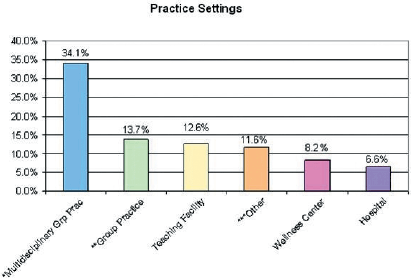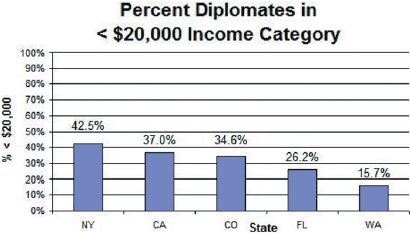Did any of you ever get the feeling in school that it simply was not OK to speak about wanting to be successful? To get into the nitty gritty details of how to make money in practice? Maybe you were even someone like me who was directly told by someone in a position of power that I needed to take what I could get because in private practice, I wouldn’t make money.
A Snapshot Of the Profession
Given the current debates taking place over the role complementary medicine (and acupuncture and Oriental medicine in particular) should play in the changing health care environment, it is important to understand where the profession is currently at. The National Certification Commission for Acupuncture and Oriental Medicine (NCCAOM) has just released the results of its national Job Task Analysis (JTA) survey, the 2008 Job Task Analysis: A Report to the Acupuncture and Oriental Medicine (AOM) Profession. This full report is available via the NCCAOM web site, www.nccaom.org. In an effort to explore the impact of the JTA on the profession, NCCAOM Chief Executive Officer, Dr. Kory Ward-Cook, PhD, MT(ASCP), CAE, took some time out of her busy schedule to discuss some of the important findings.
Q: What is the purpose of the Job Task Analysis?
A: A Job Task Analysis (JTA), also known as a practice or occupational analysis, is a critical tool to assess the growth and development of a profession. The primary purpose of the JTA report is to provide a blueprint for the development of the NCCAOM certification examinations, which serve as a prerequisite for entry-level practice of AOM in 43 states, plus the District of Columbia. The JTA confirms the importance of tasks performed by NCCAOM diplomates so that the content in each NCCAOM examination represents competencies needed for practice as a Diplomate of Acupuncture, Chinese Herbology, Oriental Medicine and Asian Bodywork Therapy practitioner.

Q: What is the process and how is it validated?
A: Active NCCAOM-certified practitioners are surveyed to gather their perceived importance of a set of job tasks for entry-level practitioners. Every five years, the NCCAOM conducts a JTA to validate the content tested on its examinations. These results serve to validate the knowledge, skills and abilities of an entry-level AOM practitioner in the United States. A group of subject-matter experts and stakeholder representatives from the AOM community develop an extensive list of tasks performed by AOM practitioners. Each task is rated for degree of importance as perceived by practitioners who entered practice at different times and who are currently in various practice settings, as well as from various regions of the country.
Diplomate respondents were asked to indicate how "adequately" or how "completely" the survey tasks covered important elements for an entry-level practitioner, which was defined as someone in their first two years of practice. All task elements were perceived as adequately or completely reflective of entry-level practice by 94 percent to 98 percent of respondents, depending upon the specific sub-content (i.e., exam area) evaluated.
Q: In addition to the competencies, was there any there additional information that was analyzed from the JTA that adds to the body of knowledge about the AOM profession?
A: Yes. Data collected and analyzed from the 2008 JTA included respondents' years in practice, certification held, type of practice setting and geographic region of the practice. A number of additional demographic and practice characteristics were also analyzed.
The workforce and demographics component of this JTA study provides significant new information concerning the hours worked per week as an AOM practitioner, the percentage of new versus returning patients and the percentage of time spent using various treatment modalities. Among the findings: Diplomates work predominantly in solo practice (90.7 percent), are self-employed and/or working for someone else (30.1 percent), practice TCM (79.1 percent), and musculoskeletal pain is the leading symptom/condition for which acupuncture is sought (39.8 percent); however, many other conditions are treated.
The range of income received by an AOM practitioner varies considerably. Gross annual income varied significantly (ranged between $20,000 or less per year to more than $160,000 per year). Only 41.7 percent indicated that they worked more than 30 hours per week as an AOM practitioner. The mean AOM education debt was $45,891.
The perceived preparedness to practice AOM after entering the profession was rated "very well prepared," "well prepared" or "prepared" by 90 percent of the diplomates for acupuncture; 87 percent for electro-acupuncture, moxabustion and cupping; 79 percent for Chinese herbology; 70 percent for Asian bodywork therapy.
Other skills such as collaboration with other health professionals, practice management, marketing and public relations, risk management, and legal/ethical issues fell significantly below the other preparedness ratings.
More research is needed in this area as it is not known whether these practitioners choose to work part-time or are forced to work part-time because of availability of work in their region. Either way, the average income for an AOM practitioner working full-time (defined as 30 hours a week or greater) is roughly $60,000 per year. However, overall average income is much less when the number of part-time practitioners are included in the analysis of income level.
Although more detailed results are available in the full JTA report, below are a few figures that support the summary of findings summarized above:



Percentage of diplomates whose income is equal to or less than $20,000 for those states with the highest diplomate response: California, New York, Florida, Colorado and Washington
Q: How do the results of the JTA actually help advance the profession?
A: The demographic and practice data gathered by the NCCAOM's 2008 JTA is being used to assist with efforts to promote the recognition of "Acupuncturists" as an independent occupation by the Bureau of Labor and Statistics (BLS). Currently, "Acupuncturists" is being tracked by the BLS's O*NET as a new and emerging profession. The results of the 2008 JTA played a vital role in providing the BLS with data that was necessary to initiate the tracking of the AOM profession. By obtaining the label of a new and emerging or bright-outlook profession (http://online.onetcenter.org/link/summary/29-1199.01 ), this should place the profession on a fast track to gain recognition as an independent profession with federal government agencies. Funding for research, insurance reimbursement and more media awareness are some of the benefits of gaining this recognition.
Additionally, the JTA report serves as a useful resource for AOM community leaders and policy makers concerned with public safety and workforce planning. Some potential areas where the data generated by the 2008 JTA may prove useful is to track changes in the job tasks performed by professional acupuncturists and practitioners of Oriental medicine, Chinese herbologists and Asian bodywork therapists over time. Another use is to provide information on competencies to AOM educators developing curricula for academic programs, and continuing-education providers planning advanced professional training. This data should be useful to inform state association leaders and regulators who enter into discussions concerning changes in state regulations and scope of practice. Also, this data can provide AOM community leaders, federal agencies and the public with a snapshot of current demographic parameters and practice characteristics of Diplomates of Acupuncture, Chinese Herbology, Oriental Medicine and Asian Bodywork Therapy. This information is useful for providing information for formulation of descriptions of a career in the AOM profession, as well as to provide ongoing data for workforce planning.
Further this document may provide policy makers with information necessary to contrast the depth and breadth of AOM competencies between licensed acupuncturists who hold NCCAOM certification and those health care professionals who desire to practice AOM after an abbreviated training program.
The complete 2008 JTA Report can be accessed via the NCCAOM web site. Please address any comments or questions regarding the 2008 JTA report to executiveoffice@nccaom.org.


